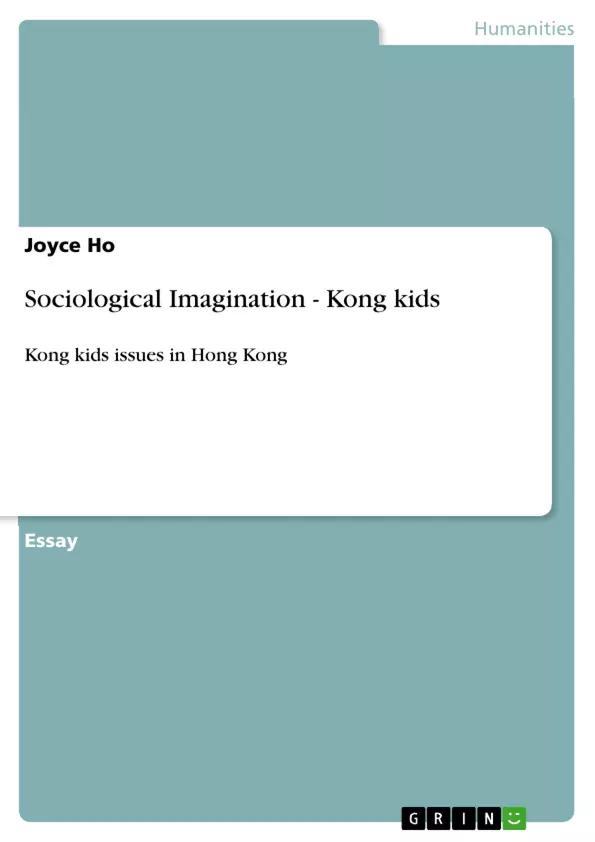Sociological imagination can be apply into varies local issues especially some current phenomenon, like Kong Kids, a special term that pops to be trendy recent years could also be explained by sociological imagination.
Inhaltsverzeichnis (Table of Contents)
- Sociological Imagination
- Kong Kids
- The Sociological Imagination and Kong Kids
- Components of Sociological Imagination
- The Problem of Kong Kids
- Media Influence and Kong Kids
- Limited Perspective of Kong Kids
- Consequences of Kong Kids
- Parental Influence and Kong Kids
- Interaction and Kong Kids
Zielsetzung und Themenschwerpunkte (Objectives and Key Themes)
This text aims to explore the concept of sociological imagination and its application to the phenomenon of "Kong Kids," a term used to describe children growing up in Hong Kong who exhibit specific characteristics such as self-centeredness and lack of independence. The text utilizes sociological concepts to analyze the factors contributing to this phenomenon, including media influence, limited perspectives, and the role of parental influence.
- Sociological Imagination and its connection to real-world issues
- The phenomenon of "Kong Kids" in Hong Kong
- The role of media and societal norms in shaping individual behavior
- The impact of limited perspectives and overprotection on personal development
- The influence of parental attitudes and behaviors on children
Zusammenfassung der Kapitel (Chapter Summaries)
- Sociological Imagination: This chapter introduces the concept of sociological imagination as defined by C. Wright Mills, emphasizing the importance of understanding the relationship between individual experiences and the wider societal context.
- Kong Kids: This chapter defines the term "Kong Kids" and describes their characteristics, highlighting their tendency towards self-centeredness and lack of independence.
- The Sociological Imagination and Kong Kids: This chapter explains how sociological imagination can be applied to understand the phenomenon of "Kong Kids" by examining the interplay between individual experiences and the social environment in which they grow up.
- Components of Sociological Imagination: This chapter outlines the three key components of sociological imagination: history, biography, and social structure.
- The Problem of Kong Kids: This chapter explores the potential problems associated with the characteristics of "Kong Kids," suggesting that their limited perspectives and overprotection may hinder their ability to adapt to the real world and contribute positively to society.
- Media Influence and Kong Kids: This chapter examines the role of media in shaping the perception of "Kong Kids," highlighting how overreporting of negative aspects can lead to stereotypes and misconceptions.
- Limited Perspective of Kong Kids: This chapter discusses the limited perspectives of "Kong Kids" stemming from their sheltered upbringing, which can make it difficult for them to understand and navigate complex social situations.
- Consequences of Kong Kids: This chapter explores the potential consequences of the "Kong Kids" phenomenon, suggesting that it may impact their competitiveness, social skills, and ability to contribute meaningfully to society.
- Parental Influence and Kong Kids: This chapter emphasizes the role of parents in shaping the characteristics of "Kong Kids," highlighting the importance of providing opportunities for growth and development beyond material possessions.
- Interaction and Kong Kids: This chapter stresses the need for interaction and engagement with the wider community to help "Kong Kids" develop a sense of belonging and responsibility, ultimately fostering a more balanced and productive society.
Schlüsselwörter (Keywords)
The main keywords and focus topics of this text include sociological imagination, Kong Kids, self-centeredness, independence, media influence, limited perspectives, parental influence, social interaction, and societal impact.
- Citation du texte
- Joyce Ho (Auteur), 2013, Sociological Imagination - Kong kids, Munich, GRIN Verlag, https://www.grin.com/document/229762



